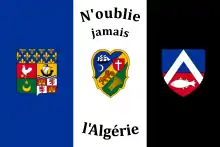Oran massacre of 1962
The Oran massacre of 1962 (July 5 – July 7, 1962) was the mass killing of Pied-Noir and European expatriates living in Algeria by members of the Algerian National Liberation Army. It took place in Oran beginning on the date of Algerian independence, and ended on July 7, 1962. Estimates of the casualties vary from a low of 95 (twenty of whom were European)[2] to 365 deaths in a report by a group of historians sent to the French government in 2006,[3] and has been a topic of speculation for right-wing elements.[4]
| Oran massacre of 1962 | |
|---|---|
| Part of the Algerian war | |
| Native name | Massacre d'Oran |
| Location | Oran, Algeria |
| Date | July 5 – July 7, 1962 |
| Target | Pied-Noirs |
| Deaths | Between 95-365 |
| Injured | ~161 |
| Perpetrators | ALN, Algerian civilians |
| Motive | Ethnic conflict |

Background
The Algerian War had been underway since 1954. The Évian Accords of March 18 1962, brought an end to the conflict. The Accords, which were reached during a cease-fire between French armed forces and the Algerian nationalist organization the Front de libération nationale (FLN), began the process of transfer of power from the French to the Algerians.
The Évian Accords intended to guarantee the rights and safety of the pieds-noirs, French and Spanish colonial residents, many born in Algeria, and indigenous Sephardi Jews in an independent Algeria. However, rumors had already spread among the pieds-noirs that their choice would be between "the suitcase or the coffin". With armed conflict apparently at an end, the French government loosened security on Algeria's border with Morocco, allowing the FLN freer movement within Algeria. The flight of French pieds-noirs and pro-French native Algerians began in April 1962, and by late May hundreds of thousands had emigrated from Algeria, chiefly to metropolitan France.
Independence had been bitterly opposed by the pieds-noirs and many members of the French military, and the anti-independence Organisation armée secrète (OAS) started a campaign of open rebellion against the French government, declaring its military to be an "occupying power".[5] The OAS declared a "scorched earth" policy to deny French-built facilities and development to the future FLN government. The OAS engaged in a bombing campaign that killed an estimated 10 to 15 people in Oran daily in May 1962.[6] Its scorched earth policy climaxed on June 7 1962, when the OAS Delta Commando burned Algiers Library and its 60,000 volumes and blew up Oran's town hall, the municipal library, and four schools.[6]
Event
Under French rule, Oran had 250,000 inhabitants of European origin. As noted, many left in the months after the accords. On the morning of July 5, 1962, the day Algeria became independent, seven katibas (companies) of FLN troops entered the city and were fired on by some Europeans.[7] An outraged Arab mob swept into the pied-noir neighborhoods, which had already been largely vacated, and attacked the estimated 40,000 remaining pieds-noirs. The violence lasted several hours, during which the mob cut the throats of many men, women and children. The massacre was ended by the deployment of French Gendarmerie.[7]
Estimates of the total casualties vary widely.
- Dr. Mostefa Naït, the post-independence director of the Oran hospital centre, claimed that 95 persons, including 20 Europeans, were killed (13 from stabbings) and 161 people were injured[6] with local newspapers giving figures in the 30 area in the days afterwards.[8]
- Some 153 French residents were listed on an Internet page in 2006[9] with the suggestion of more still.
- A group of historians in 2006 suggested 365 were killed.[3]
- A local newspaper gives the figure of 1500 deaths with no detail and no source[10] and there has been speculation of many thousands of deaths, with the former National Front Leader Jean-Marie Le Pen claiming a figure of 7,000 deaths.[11]
The number killed has been a topic of debate for right-wing elements in France in particular.[4]
Neither the Algerian police nor the 18,000 French troops in the city intervened in the massacre, at first.[7] Their orders from Paris were "do not move", leaving the pieds-noirs vulnerable. Many pied-noirs believed that the massacre was an expression of policy by the FLN and chose to emigrate to France.[7]
At the 1963 trial of Jean Bastien-Thiry, who attempted to assassinate President de Gaulle, defence lawyers referred to the Oran massacre. They said that Bastien-Thiry's act was justified because de Gaulle caused a genocide of Algeria's European population.
See also
References
- "Victimes du 5 juillet". oran1962.free.fr. Retrieved 2020-07-05.
- Benjamin Stora, Algeria, 1830-2000: A Short History (Cornell University Press, 2004) p105
- Thiolay, Boris (2006-09-13). "Algérie 1962 : La vérité sur les massacres d'Oran". L'Express. Retrieved 12 November 2012.
- "Pourquoi la droite réhabilite-t-elle le colonialisme ?". Télérama (in French). Retrieved 2020-07-05.
- See Le Figaro, March 24–25, 1962, (see "La fusillade de la rue d’Isly, l’exode des pieds-noirs, Oran", Human Rights League, March 2002
- la fusillade de la rue d’Isly, l’exode des pieds-noirs, Oran--no exits this link, Human Rights League, March 2002
- Alistair Horne, page 533 A Savage War Of Peace, ISBN 0-670-61964-7
- Zeller, Guillaume (2013-02-28). Oran, 5 juillet 1962: Un massacre oublié (in French). Tallandier. ISBN 978-2-84734-885-9.
- "Victimes du 5 juillet". oran1962.free.fr. Retrieved 2020-07-05.
- , CHRONOLOGIE DE LA GUERRE D'ALGÉRIE, LES JOURNAUX D'ALGER
- Zeller, Guillaume (2013-02-28). Oran, 5 juillet 1962: Un massacre oublié (in French). Tallandier. ISBN 978-2-84734-885-9.